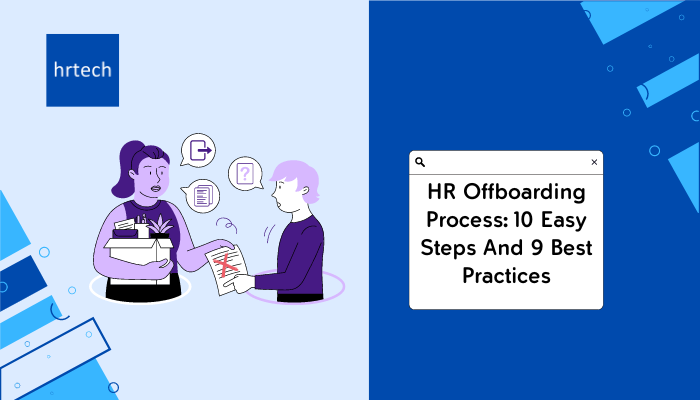The HR offboarding process doesn’t have to be complex or confusing. With the right policies, steps, and the best practices in mind, you can easily create a well-structured HR offboarding process for your company.
Learn what offboarding actually means, what essential things to include in the offboarding policy, and a step-by-step breakdown of the offboarding process, along with a checklist.
What Is HR Offboarding?
HR offboarding is the process of managing an employee’s departure from your company. It’s the opposite of onboarding, which focuses on welcoming new hires and getting them settled in their roles.
Offboarding isn’t just about collecting company property and revoking access privileges. The best offboarding programs go further, aiming to leave a positive lasting impression on the departing employee.
An effective offboarding process includes:
- Treating the employee with respect and appreciation
- Conducting an exit interview to gather valuable feedback
- Ensuring a smooth transition of duties to other team members
- Maintaining open lines of communication after the employee leaves
A thoughtful, well-executed offboarding process reflects well on your company culture and employer brand. It can even turn former employees into brand supporters who refer great talent your way in the future.
Why Is the HR Offboarding Process Essential?
A strong HR offboarding process is crucial for several reasons:
1. Protects Company Assets And Data Security:
Offboarding ensures you revoke the departing employee’s access to systems, accounts and confidential information. This prevents data breaches and intellectual property leaks.
2. The Opportunity To Gather Honest Employee Feedback:
Exit interviews give you a unique opportunity to collect honest insights about your company, management, culture, and areas for improvement. This feedback is invaluable for driving positive organizational change.
3. Maintains Team Morale And Productivity:
Having a clear offboarding plan minimizes disruptions and confusion when someone leaves. It allows you to seamlessly transition projects and equitably redistribute workloads.
4. Leaves The Door Open For Boomerang Employees:
Treating exiting-employees with respect makes it more likely they’ll consider returning to your company in the future (boomerang employees are essentially rehired employees). Rehiring former employees who already know your business can save significant time and money.
5. Protects Your Employer Brand And Reputation:
Former employees often share their experiences online on sites like Glassdoor. A negative offboarding experience can lead to critical reviews that damage your ability to attract top talent. On the flip side, positive offboarding stories can bolster your employer brand.
Offboarding Policy And Procedures
An offboarding policy lays out the steps and responsibilities for managing an employee’s departure from your company. It’s a roadmap that ensures the exit process is handled consistently and professionally every time.
Without a clear policy, offboarding can become disorganized and haphazard. Important steps might get overlooked, like:
- Collecting company equipment
- Ending system access
- Conducting exit interviews
- Transferring knowledge to team members
This can lead to security risks, lost intellectual property, drops in team productivity, and an improper last impression on the employee.
A well-defined offboarding policy:
- Protects sensitive data and company assets
- Prevents legal issues and compliance violations
- Ensures a smooth handover of projects and duties
- Helps you gain valuable feedback to improve the workplace
- Leaves former-employees with a positive view of your company
The offboarding process often begins with an offboarding email from HR to key departments and key decision makers. This email should cover:
- The employee’s last day
- A checklist of offboarding tasks
- Who is responsible for each task
- Due dates for completing tasks
The email keeps everyone looped in and accountable for their part in the offboarding process.
A complete offboarding policy highlights tasks and responsibilities for:
- HR – Conducts exit interview, manages final pay and benefits
- IT – Ends system access, collects company devices
- The employee’s manager – Ensures knowledge transfer, reassigns work
- Facilities – Takes back building keys/access card
- Legal – Reviews any non-compete or confidentiality agreements
The policy should also highlight how to handle different exit scenarios like:
- Voluntary resignations
- Involuntary terminations
- Layoffs
- Retirements
Having all of this well-documented keeps offboarding running smoothly and avoids missing out important steps.
HR Offboarding Process: Complete Breakdown Step-By-Step
When an employee leaves your company, having a strong offboarding process is essential. It ensures a smooth transition and protects your business. Here’s a step-by-step breakdown of a typical HR offboarding process:
Step 1 – Employee Gives Notice
The offboarding process starts when an employee tells their manager they’re leaving. The employee should give this news in writing, usually via email. They should include their last day of work. Most companies ask for two weeks’ notice, but this varies. Once the manager gets the news, they should tell HR right away.
Step 2 – HR Meets With Employee
HR should set up a meeting with the leaving employee. In this meeting, HR will:
- Go over the offboarding process and timeline
- Ask about the employee’s reason for leaving
- Answer any questions about final pay, benefits, etc.
This meeting sets expectations and starts things off on a good note.
Step 3 – Communicate the Employee’s Departure
Next, it’s time to tell others about the employee’s exit. The manager should tell the employee’s team and any other key coworkers. They should also tell any clients or outside partners who work closely with the employee.
The message should be simple and positive. It should include:
- The employee’s last day
- A thank you for the employee’s work
- Who will take over the employee’s duties
Sending this news quickly helps avoid gossip and keeps work running smoothly.
Step 4 – Transfer Knowledge
Before the employee leaves, their knowledge needs to be passed on to team members. The manager should have the employee:
- Write out key processes and information
- Train coworkers on their duties
- Introduce coworkers to key clients or contacts
This step is critical to make sure important skills and information aren’t lost.
Step 5 – Hand Off Projects and Clients
The employee also needs to hand off any projects or clients they’re working with. This means:
- Letting clients know about the change
- Bringing coworkers up to speed on project statuses
- Passing along any important files or documents
The handoff should happen in the last few days before the employee leaves. This timing helps make the change feel seamless.
Step 6 – Complete an Exit Interview
An exit interview is a valuable tool for understanding why an employee is leaving. It’s a chance to:
- Get honest feedback about your company
- Learn about any issues or concerns
- Gather ideas for improving the workplace
HR usually does the exit interview on the employee’s last day. They ask the employee about their experience and reasons for leaving. It’s important to listen and take notes.
Step 7 – Collect Company Property
On the employee’s last day, you need to collect any company property they have, like:
- Laptop
- Phone
- ID badge
- Keys
HR should have a checklist to make sure nothing gets missed. This step helps protect company assets and data security.
Step 8 – Cut Off Access
Also on the last day, the employee’s access to company systems needs to end. This includes:
- Network logins
- Building access
- Any software or tools
IT usually handles this step. They should have a set process for quickly removing access to avoid any issues.
Step 9 – Process Final Pay
The last big step is to get the employee their final paycheck. This paycheck needs to include:
- Regular wages through the last day
- Any leftover PTO or vacation pay
- Expenses or commissions owed
The final paycheck should come on the next regular payday, or sooner if the regulations require it. It’s key not to delay this payment.
Step 10 – Final Things To Update And Note
After the employee leaves, there are still a few things to take care of:
- Update employee directories and org charts
- Reassign the employee’s email to the manager
- Send the employee health insurance information
- Answer any final questions from the employee
So, having a well-documented off-boarding process like this sets your team up for success. It ensures you handle each employee’s exit professionally, following all the required regulations.
Best Practices For Effective HR Offboarding
Here are the top 9 best practices for an effective HR offboarding process:
1. Start Early
Begin the offboarding process as soon as the employee gives notice, usually two weeks before their last day. This gives you time to finish off remaining important tasks without rushing.
2. Be Organized
Have a clear checklist of offboarding tasks and who’s responsible for each. This keeps the process on track and avoids missed steps.
Here’s the HR offboarding checklist:
As you can see in the above employee offboarding checklist, there are several things to consider during the offboarding process. Here’s a further breakdown of the entire offboarding process based on timelines:
- 2 weeks before the last working day – Everything from resignation letter to knowledge transfer happens during this phase.
- 1 week before the last working day – Preparing their final pay check and planning their last working day event.
- 3 days before last working day – Collecting the company assets and properties back
- 2 days before the last working day – Working with the IT department to stop system access.
- Last working day – From conducting exit interview, to handling final paycheck and finishing offboarding paperwork.
- 1-2 days after the last working day – Updating records, transferring responsibilities, and forwarding emails
- 1-2 weeks after the last working day – Sending the post-exit survey.
3. Communicate Clearly
Let the team and key partners know about the employee’s upcoming departure. Share the transition plan so everyone knows what to expect.
4. Focus On Knowledge Transfer
Have the employee document key processes and train team members on their duties. Capture this critical knowledge before they leave.
5. Conduct A Thoughtful Exit Interview
Use the exit interview to get candid feedback about your company. Ask about the employee’s reasons for leaving and any suggestions for improvement. Really listen and look for patterns across interviews.
6. Show Appreciation
Take time to celebrate the employee’s accomplishments and thank them for their work. Write a recommendation on LinkedIn or share a kind message with the team. A little appreciation goes a long way.
7. Be Efficient On The Last Day
Have a plan for the employee’s last day so it’s smooth and productive.
Collect all company property, do the exit interview, and process final paperwork. Make it a positive closing experience.
8. Remove Access And Update Data
As soon as the employee leaves, remove their system access and building entry.
Update your org chart, forward their email, and finish any other wrap-up tasks within a few days.
9. Stay In Touch
Wish the employee well and let them know you’re happy to be a reference. Invite them to join your company alumni group if you have one.
Maintaining a good relationship can lead to rehiring, referrals, or other opportunities.
What Is A Boomerang Employee?
When an employee leaves your company, there are several key things to keep in mind during the offboarding process.
But out of all, here’s the most important thing to consider:
Each departing employee has the potential to be rehired again in the future as—Boomerang employees—workers who leave a company but later return.
They might come back in a different role or department.
Rehiring former employees can save a lot of time and money on recruiting and training.
To encourage boomerang employees:
- Make offboarding a positive experience.
- Treat exiting-staff with respect and appreciation.
- Let them know they’d be welcomed back in the future.
Now, as we’re speaking of offboarding, it’s also essential to consider how offboarding differs from the onboarding process.
Onboarding vs. Offboarding – How Do They Compare?
While onboarding focuses on welcoming and integrating new hires, offboarding is about smoothly transitioning exiting-employees out of the company.
| Onboarding: | Offboarding: |
| Welcoming new hires | Transitioning exiting employees |
| Orientation and training | Knowledge transfer and handover |
| Setting up accounts and access | Revoking accounts and access |
| Integrating into company culture | Conducting exit interviews |
| Buddy or mentor assignment | Celebrating contributions and achievements |
Use Of Technology In Offboarding
Now, just like onboarding, offboarding can greatly benefit from HR technology. Automating offboarding tasks with software brings consistency and efficiency to the process.
Popular HR platforms like BambooHR, and Workday have built-in offboarding features.
These can include:
- Offboarding checklists and workflows
- Automatic account and access revocation
- Exit interview scheduling and questionnaires
- Compliance and document management
Using technology simplifies offboarding in several ways:
- Ensures all necessary steps are completed consistently.
- Saves time on manual tasks and paperwork.
- Provides a clear audit trail and documentation.
- Allows HR to spot trends in exit interview data.
Pro-Tip: When implementing offboarding software, be sure to document the process. Create written instructions for each step in the system. This helps keep offboarding running smoothly, even if the HR team changes.
Advantages of automating offboarding include:
- Reduced risk of missed steps or compliance issues.
- More time for HR to focus on strategic tasks.
- Improved data collection and analysis from exit interviews.
- Smoother, less awkward offboarding experience for employees.
Did you know that at our hrtech’s marketplace you can find several HR softwares and tools that’ll help you simplify your HR processes? Explore more about it now!
Common Offboarding Mistakes To Watch Out For
When an employee leaves your company, it’s easy to let the offboarding process fall through the cracks. But neglecting offboarding can have serious consequences. For instance, forgetting key steps like knowledge transfer and exit interviews can leave your team in the lurch.
Projects may stall and critical information may be lost. This can hurt morale and productivity for the existing employees of the company. Similarly, failing to treat departing employees with respect can have bad consequences as well.
A negative offboarding experience can lead to bad online reviews that scare away top talent. It may even inspire some former employees to badmouth your company to others.
To avoid these mistakes:
- Make offboarding a priority.
- Assign clear roles and time limits to ensure each step gets done.
- Have the departing employee document their duties and train others to take over.
- And don’t forget the exit interview—it’s a great opportunity to gather feedback and improve the company’s employee retention and overall HR processes.
Most importantly, be kind and professional throughout the process. Thank the employee for their contributions and wish them well.
A little appreciation can turn an awkward situation into a positive last impression.
Using Offboarding To Enhance Company Culture
Believe it or not, offboarding is a great chance to boost your company culture. How? By using it to show that you value feedback and want to keep improving. In the exit interview, really listen to what the employee has to say. Ask about their reasons for leaving and what would have convinced them to stay.
Take notes and look for patterns across multiple interviews. This feedback is a gift – use it to make meaningful changes in your workplace. Also, use the exit interview to remind the employee of the good times. Discuss how they grew in their role and the successes they achieved.
Highlight the relationships and memories they built. This positive reflection can reaffirm your company’s values and make the employee more likely to speak well of you in the future. Finally, make the employee’s last day at work special. Gather the team for coffee and cake to celebrate the person’s contributions. Give a thoughtful card signed by colleagues.
These gestures show that your company cares about its people, even when they move on.
As you handle the offboarding process with respect, gratitude, and a growth mindset, you can actually enhance your culture and reputation.
Former employees may recommend great hires, become clients, or even return to work for you again someday.
In the long run, treating offboarding as a culture-building opportunity is a win-win for everyone.
Conclusion
The HR offboarding process may mark the end of someone’s employment, but it doesn’t have to be the end of the company’s relationship with them.
Handling offboarding with care and professionalism leaves a lasting positive impression that can benefit the company for years to come.
Want to learn more HR concepts and enhance your skills? Explore specialized courses, and certification programs at hrtech. We’ve partnered with well-known HR brands, and as a result, we are able to offer huge discounts on major training programs. Check it out now!





